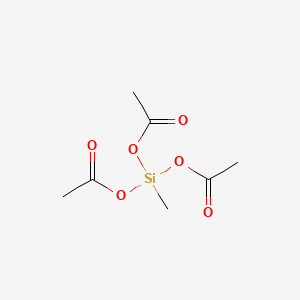D0998 | methylsilanetriyl triacetate
| Toxicity | Dose | Time | Species | Model | Method | Action | Positive criterion | Reference |
|---|---|---|---|---|---|---|---|---|
| MEMBRANE POTENTIAL | 29.07±16.38 | human | qHTS-HepG2 | MMP assay | decrease | IC50 | 163 | |
| MEMBRANE POTENTIAL | human | HepG2 | MMP assay | Negative | IC50 | 163 | ||
| MEMBRANE POTENTIAL | rat | hepatocytes | MMP assay | Negative | IC50 | 163 | ||
| Pictogram | Signal | Statements | Precautionary Statement Codes |
|---|---|---|---|
  |
Danger |
Aggregated GHS information provided by 519 companies from 21 notifications to the ECHA C&L Inventory. Each notification may be associated with multiple companies. Reported as not meeting GHS hazard criteria by 5 of 519 companies. For more detailed information, please visit ECHA C&L website Of the 20 notification(s) provided by 514 of 519 companies with hazard statement code(s): H302 (72.76%): Harmful if swallowed [Warning Acute toxicity, oral] H314 (85.02%): Causes severe skin burns and eye damage [Danger Skin corrosion/irritation] H315 (22.37%): Causes skin irritation [Warning Skin corrosion/irritation] H318 (20.04%): Causes serious eye damage [Danger Serious eye damage/eye irritation] H319 (22.18%): Causes serious eye irritation [Warning Serious eye damage/eye irritation] H335 (14.79%): May cause respiratory irritation [Warning Specific target organ toxicity, single exposure Respiratory tract irritation] Information may vary between notifications depending on impurities, additives, and other factors. The percentage value in parenthesis indicates the notified classification ratio from companies that provide hazard codes. Only hazard codes with percentage values above 10% are shown. |
P260, P261, P264, P270, P271, P280, P301+P312, P301+P330+P331, P302+P352, P303+P361+P353, P304+P340, P305+P351+P338, P310, P312, P321, P330, P332+P313, P337+P313, P362, P363, P403+P233, P405, and P501; (The corresponding statement to each P-code can be found at the GHS Classification page.) |
   |
Danger |
H302: Harmful if swallowed [Warning Acute toxicity, oral] H314: Causes severe skin burns and eye damage [Danger Skin corrosion/irritation] H318: Causes serious eye damage [Danger Serious eye damage/eye irritation] H371: May cause damage to organs [Warning Specific target organ toxicity, single exposure] |
P260, P264, P270, P280, P301+P312, P301+P330+P331, P303+P361+P353, P304+P340, P305+P351+P338, P309+P311, P310, P321, P330, P363, P405, and P501; (The corresponding statement to each P-code can be found at the GHS Classification page.) |
| Organism | Test type | Route | Dose (normalized dose) | Effect | Source |
|---|---|---|---|---|---|
| rat | LD50 | oral | 2060mg/kg (2060mg/kg) | "Prehled Prumyslove Toxikologie; Organicke Latky," Marhold, J., Prague, Czechoslovakia, Avicenum, 1986Vol. -, Pg. 1229, 1986. | |
| 4-04-00-04208 (Beilstein Handbook Reference) | 4253-34-3 | A19554 |
| AKOS008901251 | ANW-29829 | APK 1 (silane derivative) |
| BRN 1788668 | C-34701 | CAS-4253-34-3 |
| CC-30921 | CH3Si(OCOCH3)3 | CHEMBL3184776 |
| CM8980 | CTK3J1367 | DSSTox_CID_7565 |
| DSSTox_GSID_27565 | DSSTox_RID_78506 | DTXSID0027565 |
| EC 224-221-9 | EINECS 224-221-9 | FT-0689240 |
| J-522700 | K 10S | KS-00000VV3 |
| KSC491G6P | LS-145223 | MCULE-3227275066 |
| MFCD00008694 | Methylsilanetriol triacetate | Methylsilanetriyl triacetate |
| Methylsilanetriyl triacetate | Methyltriacetoxysilane | Methyltrihydroxysilane triacetate |
| NCGC00248787-01 | NCGC00258217-01 | NSC 139845 |
| NSC-139845 | NSC139845 | RTR-016640 |
| SCHEMBL63651 | Silane, methyltriacetoxy- | Silanetriol, 1-methyl-, 1,1,1-triacetate |
| Silanetriol, methyl-, triacetate | TR-016640 | TRA0067854 |
| TVJPBVNWVPUZBM-UHFFFAOYSA-N | Tox21_200663 | Triacetoxy(methyl)silane |
| Triacetoxy(methyl)silane, technical grade, 90% | Triacetoxy(methyl)silane; | Triacetoxymethylsilane |
| ZINC169746434 | bis(acetyloxy)(methyl)silyl acetate | methyltriacetoxysilan |
| s11725 | triacetoxy(methylsilane) |
| CAS Number | 4253-34-3, 4605-47-4 |
| PubChem Compound | 77929 |

